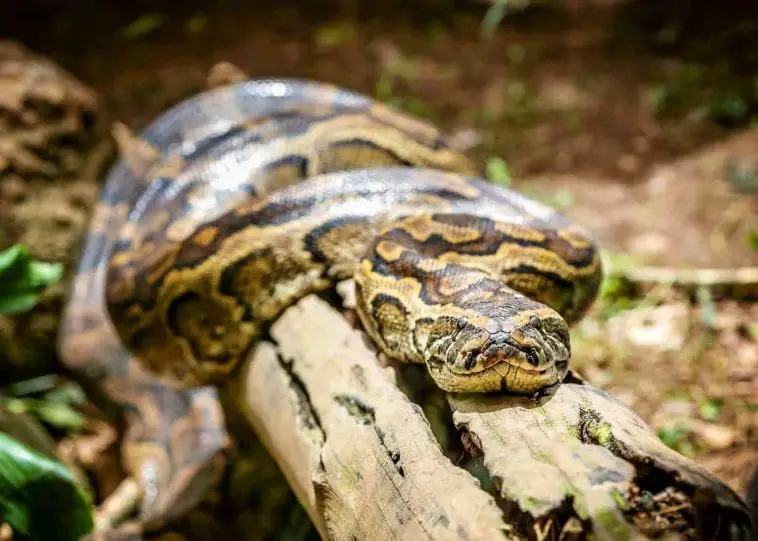Scientific Facts
| Common Name | African Rock Python |
| Scientific Name | Python sebae |
| Captive Lifespan | More than 20 Years |
| Size | 3 meters on an average (sometimes up to 6 meters) |
| Mass | About 32-55 kg (occasionally up to 90 kg) |
| Habitat | Savanna, forest, rocky areas, semi-desert areas, grassland, near permanent water sources (lakes, rivers, swamps) |
| Country of Origin | Central and Western Africa |
Physical Description
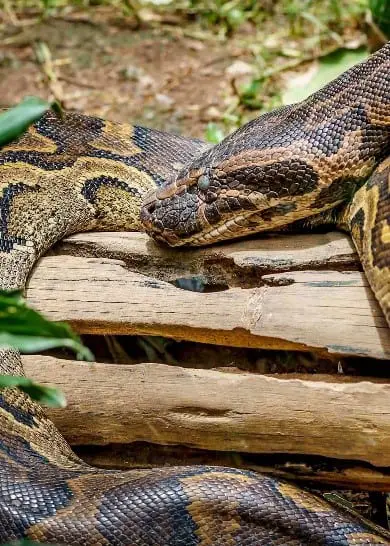
African rock pythons are known as Africa’s largest snake species. Adults typically measure from 3 to 5.50 meters. However, unusually large specimens can exceed 4.8 meters in length.
The average weight of adult African rock pythons is set between 44 to 55 kilograms (respectively, 97 – 121 Ib.).Other studies point out to the average mass of these serpents falling into the 30 kilograms (71 Ib.) range, with unusually large specimen capable of reaching more than 91 kilograms (201 Ib.).
As with most snake species, female African rock pythons are usually bigger than the males.
The body of the African rock python is muscular, thick, and covered in distinctly colored blotches. These blotches typically join up in an irregular, wide stripe.
The body markings coloration varies from chestnut, olive, brown, and yellow. On the underside of the python’s body, the markings fade to white.
The top of the head of the African rock python is marked with a spear-head-like, dark brown color pattern which is further outlined in buffy yellow. The very shape of the head is triangular.
The teeth of African rock pythons are backwardly curved. They are many and are quite sharp.
Right under the eye, the African rock python possesses a distinct triangular marking, which is referred to as the subocular mark.
The scales of these snake species are very smooth and small in size. The scales located around the lips are equipped with heat-sensitive pits. These pits serve the purpose of detecting warm-blooded prey at any time, even in the darkness of the night.
More advanced snake species have only one lung, but African rock pythons have two lungs.
Types
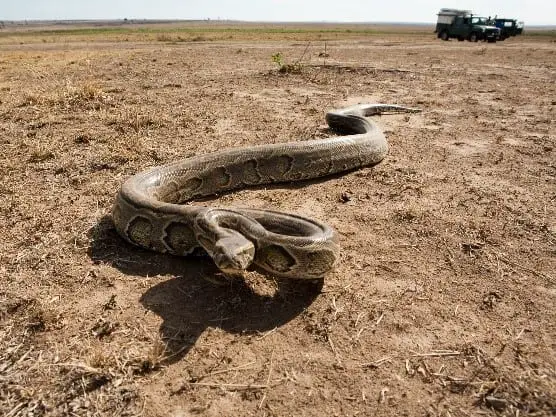
There are two subspecies of African rock pythons, namely Python sebae sebae and Python sebae natalensis.
Python sebae sebae(aka African rock python) can be found in West and Central Africa’s countries, such as Uganda, Ethiopia, and Senegal.
Python sebae natalensis(aka Southern African rock python) can be found in various regions in Southern Africa, such as in Zimbabwe and Kenya.
The southern subspecies (Python sebae natalensis) shares many similarities with the African rock python’s appearance. However, the Southern African rock python can be distinguished by the smaller scales on top of the head, the smaller (or totally absent) subocular mark, as well as by its smaller size in general, since adults average about 2.4 – 4.4 meters.
Nowadays, there are only a few variations of African Rock Python which have been bred specifically, therefore, showcasing patterns that cannot be found in the wild. These particular African rock python’s varieties are called morphs.
Patternless
Just like the name suggests, patternless African Rock Pythons possess muted blotches. In fact, the blotches might be missing altogether. The coloration of patternless African rock pythons varies from golden or plain dark backgrounds to shades of lavender.
Hypomelanistic
Hypomelanistic stands for hypo = under + melan, meaning that this particular morph has retained some of its black pigmentation in the process of losing most of it. Therefore, hypomelanistic African rock pythons have reduced black pigments. The coloration ranges from light olive to dark gold. There is also specimen with coloration that is almost absent of both pattern and color.
Striped
Striped African Rock Pythons are known to possess many stripes. Usually, these stripes may vary in width, but in some cases, there is only a single stripe that runs all the way from the head to the tail following the full length of the spine. These morphs’ coloration also varies, ranging from lighter banana-golden tones to dark, neutral nuances.
Habitat & Lifespan
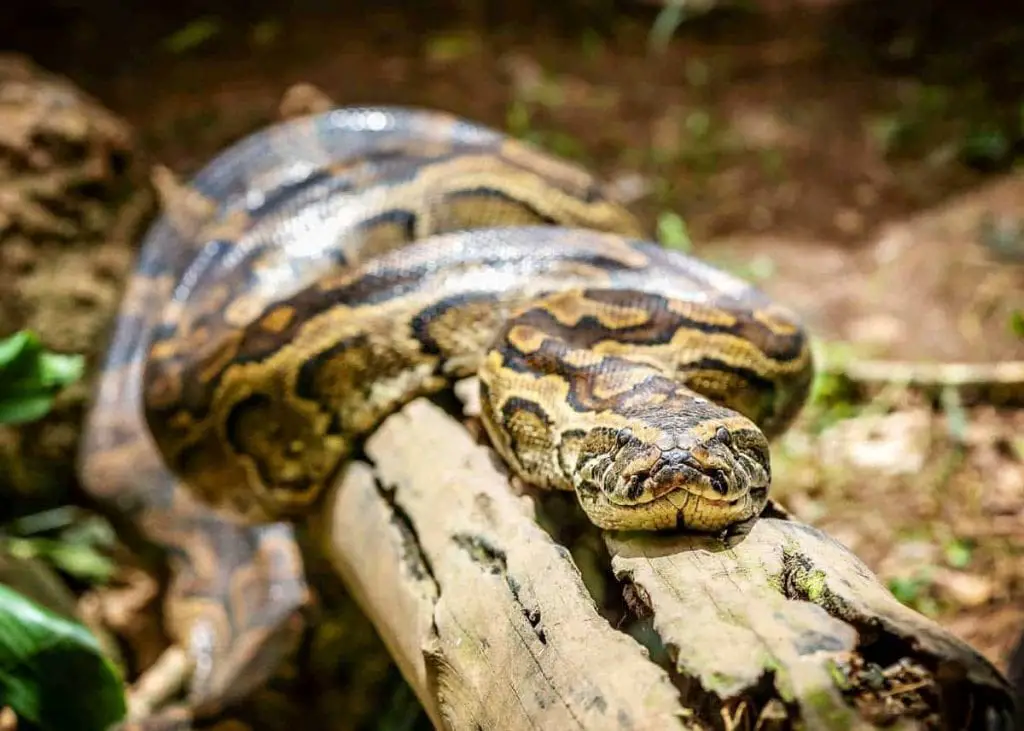
African rock pythons are found throughout most of Central and Western Africa, while southern African rock pythons inhabit the southern and eastern range of the continent.
The habitat of African rock pythons is quite diverse, as these snakes are known to inhabit grassland, forest, savanna, and semi-desert areas, all the way to rocky areas.
In particular, African rock pythons are most frequently to inhabit regions where permanent water sources are present. That’s why in the wild, these serpents are commonly spotted on the edges of rivers, swamps, and lakes.
African rocks are also commonly found in cane fields, as they are masters of adapting to disturbed habitats close around human population and habitation.
In captivity, African rock pythons can live for up to 30 years, although their average lifespan is about 20+ years.
Behavior
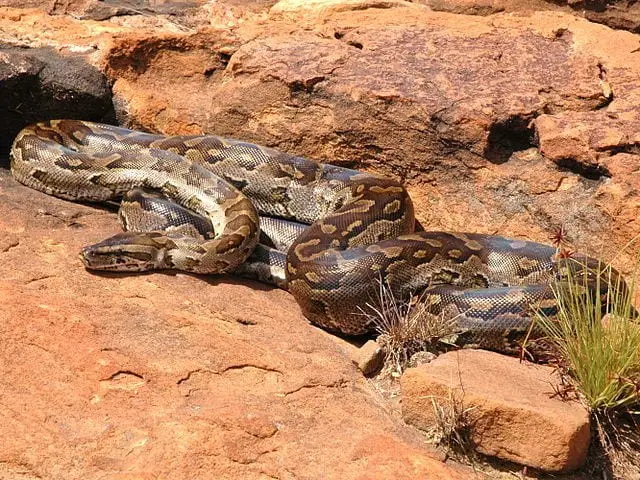
Similarly to many other snakes, the African rock python is a fairly solitary creature. It only seeks out to communicate with its own kind on very rare occasions, and in particular, solely during the breeding season.
Rock pythons typically stay on the ground, which has much to do with their large, heavy bodies. However, these snake species do sometimes climb up in the trees, too, although they do so only if an urgent need is to arise.
African rock pythons are excellent swimmers. They can stay submerged in the water for quite some long time, and they use this advantage for the purpose of successfully avoiding any potential threat.
Even though adult African rocks are primarily nocturnal creatures, they can be also spotted to be active throughout the day, and that’s mostly due to the need for basking in the sun because of thermoregulation.
Juvenile African rock pythons, though, are primarily active at dawn and dusk. They prefer to retreat to a hollow tree or a rock formation during both the day and the night, as doing so allows them to find a safe place away from potential threats.
Unfortunately, African rock pythons have earned a reputation as being quite aggressive snakes, which has much to do with their rather spirited defensive behavior, as well as their well-pronounced feeding responses.However, if treated with care, respect, and patience, captive African rock pythons can easily become semi-docile.
In the case an African rock python is to feel threatened, it will inevitably follow its instincts and bite before it constricts with stunning ferocity.
Caging
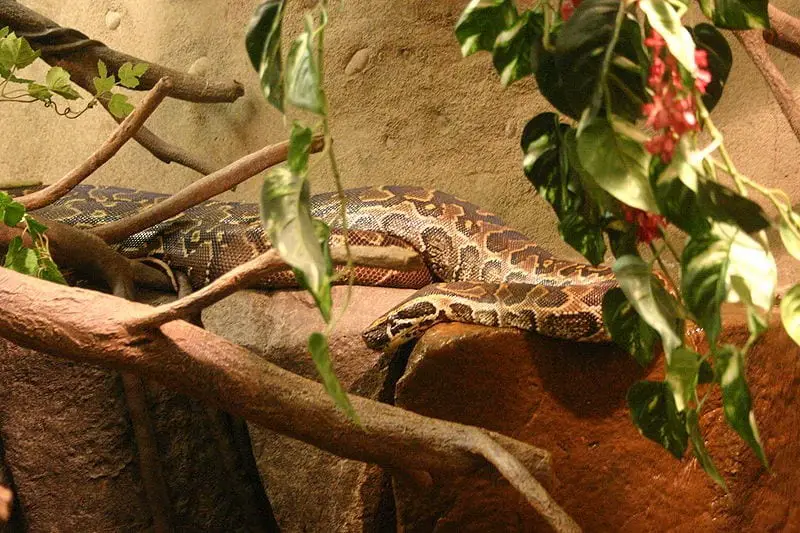
- As a rule of thumb, African rock pythons require a large terrestrial vivarium. These snake species must not be confined in small spaces, as this will not only affect their health but also their temper.
- A wooden vivarium is one of the best choices. Wood is a reliable heat insulator, making up for controlling the temperatures within the enclosure easy and precisely, which is crucial for the serpent’s well-being.
- If keepers are to adopt a DIY attitude by constructing a wooden vivarium from scratch rather than purchasing a readily-available one from reputable zoo shops, it is a must to make sure the wood material is not treated with toxic chemicals which can release fumes that are harmful to the reptile’s well-being in the long run.
- Proper ventilation within the enclosure is also crucial. Good airflow both in and out of the enclosure must be ensured by the caregivers.
- Juvenile African rock pythons need an enclosure that measures 2ft in depth vs. 2ft in height vs. 4 ft. in length.
- As the juveniles continue to grow, their enclosure must be upgraded into much bigger dimensions. Adult African rock pythons can thrive in an enclosure measuring at least 7x2x2ft. However, females require a larger enclosure than males, about 8x3x3ft.
- When setting an African rock’s vivarium, mind that decoration is extremely significant, and that’s not merely because of aesthetic purposes. Decorating the enclosure the right way as to resemble the natural habitat of the reptile will make up for a more docile pet. The snake will feel safe and secure, and it will be able to fully use its enclosure with confidence.
- Hiding areas are crucial. Various artificial or live plants, as well as wood (especially driftwood), can be used to decorate the vivarium and enhance the snake’s environment.
- For juvenile African rock pythons, it is best that keepers are to further include vertical structures. Given the opportunity, juveniles will enjoy climbing. In order to create a vertical structure, opt for vines and/or natural wood decorations.
Substrate
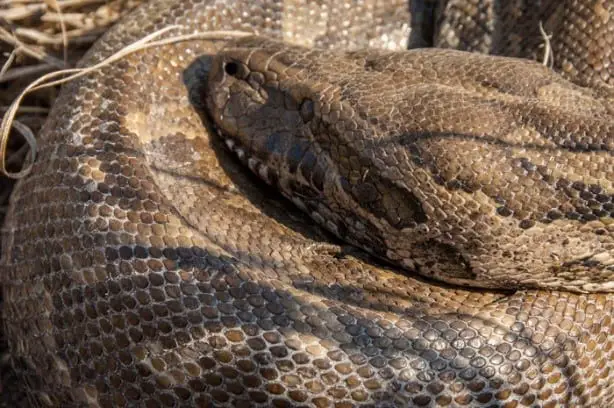
1. As a rule of thumb, any type of loose substrate is best to be avoided as it has the potential (regardless of how small this potential is) for being accidentally swallowed by the reptile. In short, and especially in the long run, this can easily lead to unwanted health issues.
2. Coarse beech woodchips make a suitable substrate for African rock pythons as the particles are not too small as to be swallowed by the reptile. Plus, it is very easy to clean and maintain.
3. Reptile carpets make a wonderful substrate for African rock pythons but if in a pinch, even newspaper can be used with ease, as long as caregivers are diligent and attentive when it comes to changing the substrate regularly as not to allow urine and feces to accumulate.
4. At any cost, avoid pine or cedar shavings. The aromatic oils in these trees will cause irritation o the snake’s skin. Not the least, the respiratory illness can occur, too.
5. Mulch substrate can make an excellent choice since it provides the best of both worlds; it looks quite natural while being effortless to spot clean.
Temperature, Lighting & Humidity
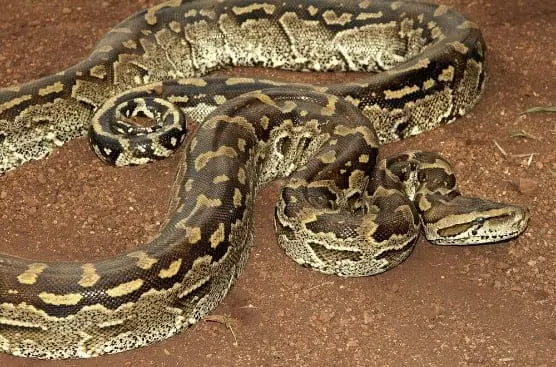
Caregivers need to mind that it often tends to be difficult to heat the enclosure of African rock pythons properly, majorly because of their enclosures being so wide in size.
On the warm end, temperatures must be kept within the 88 – 92 degrees Fahrenheit range. For this purpose, using an AHS unit placed on one side of the enclosure and controlled by a pulse thermostat can work excellently. A ceramic heat emitter can be utilized with the same ease and effectiveness. Under-tank heaters, overhead lights and space heaters can be also used in order to provide the serpent with a hot spot.
Important Note: Ceramic heat bulbs must be guarded properly. The snake must not come into direct contact with the bulbs. Also, do not forget that temperatures should be monitored every day using a reliable thermometer.
In the case keepers are to utilize ceramic as the only heat source, it is highly recommendable that LED lights are also introduced. Using LED lights will make up for providing a good day/night cycle for the African Rock Python. The lights should be kept ON for at least 10 and up to 12 consecutive hours a day.
A temperature gradient for the air during the daytime should be provided, maintaining it within the 86 – 88 degrees Fahrenheit range. At night, the air temperatures should best drop to about 80 degrees Fahrenheit.
Pig Blankets
Pig blankets are giant heating pads. These are enclosed in rigid plastic, emitting high surface heat over a rather broad zone within the enclosure. Best of all, pig blankets are effortless to control with thermostats.
Ceramic Heaters
Ceramic heaters can work great as overhead heat sources. However, do keep in mind that ceramic heaters require a sturdy ceramic basis in order to handle the wattage, and nonetheless, the correct wattage bulb is also required.
Plastic sockets do often come cardboard liners. Cardboard liners typically begin to burn after just a couple of hours. In any case, thermostats or rheostats should be used if an African rock python keeper is to opt for ceramic heaters.
Heat Pads and Tapes
Without any doubt, heat pads and tapes are the easiest way to heat an African rock python’s enclosure. Owners simply need to make sure that these are connected to thermostats for the purpose of providing a reliable temperature gradient within the enclosure.
Keeping a large water bowl inside the enclosure should be enough to maintain the humidity levels within the optimal rates since Afrocks do not require high levels of humidity like other snake species do.
Diet

In the wild, the carnivorous African rock python feeds on a wide variety prey, including monkeys, fruit bats, antelopes, large rodents, monitor lizards, and nonetheless, even crocodiles when it comes to the pythons inhabiting forest areas. African rock pythons inhabiting suburban areas will also feed on poultry, rats, goats, and dogs.
Although only occasionally, African rocks may eat big cats’ cubs, such as the cubs of lions, cheetahs, and leopards. It is important to note, though, that adult wild cats can effortlessly kill African rock pythons and/or fend them away.
Eating big dogs’ puppies, such as those of African Wild Dogs and hyenas is also sometimes part of the menu of these powerful reptiles.
The diet of captive African rock pythons consists of frozen-thawed rats, rabbits, and mice.
Small and young African rocks will typically need a frozen mice meal once a week on an average.
As the snake gets bigger, so must the size of the prey fed to the reptile get bigger, too, starting from small mice through big mice and all the way to appropriately-sized rabbits for mature African rock pythons.
Fully grown adults will need a large meal provided only once every 4 – 6 weeks.
Eating Habits
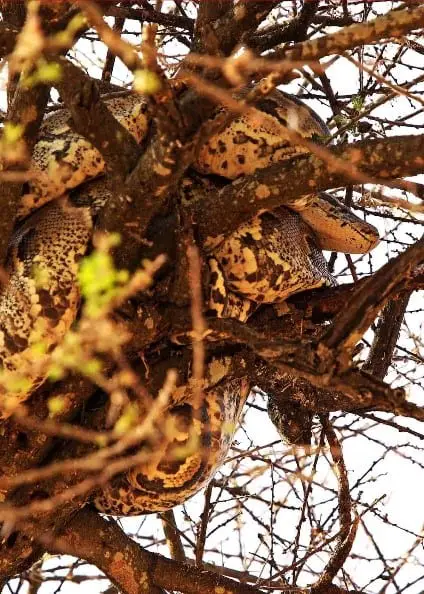
Like all python species, the African rock python is also non-venomous. The way this serpent kills its prey is by constriction.
Once the African rock python grips the prey, it then coils around it. Every time the victim breathes out, the python tightens its coils in return.
Death is believed not to be caused by crushing or asphyxiation but rather than that, by cardiac arrest.
Sleeping Habits
Adult African rock pythons are primarily nocturnal creatures.
With the exception of getting less active during the dry seasons in the wild, African rock pythons do not hibernate.
The time of the year when these snake species may become less active are also known as “dormant seasons,” greatly depending on the weather in the particular region an African rock python is to inhabit in nature.
What is typical for the behavior of African rock pythons in their natural habitat during the dormant seasons is that they stop nesting, mating, hunting and exploring new territories like they typically do until the weather becomes more favorable.
Water

African rock pythons are good swimmers, and adequate access to fresh water is crucial for these reptiles.
Fresh, clean water must be always available for both bathing and drinking purposes. With this in mind, keepers should make sure to change the water on a daily basis, so that it remains fresh at all times.
The water bowl should be large enough for the serpent to freely and fully submerge itself inside. Also, the water bowl should be placed on the cool end of the enclosure.
Development and Reproduction

For African rock pythons reproduction occurs during the spring season.
These snake species are oviparous. After successfully mating with a male African rock python, the female would lay between 20 and 100 elongated eggs which are hard-shelled. The eggs are to be laid in a cave, termite mound or an old, abandoned animal burrow.
Despite their bad reputation as cold-blooded, aggressive animals, the female African rock pythons show an amazing level of maternal care to their young. The mother is to coil around the eggs, dedicatedly protecting them from predators while also helping the eggs to incubate.
The eggs usually hatch about 90 days after being laid.
What’s even more surprising about the maternal instinct of female African pythons is that based on a recent discovery, the mother is to keep guarding the young against predators for about two weeks after the eggs have been hatched.
African rock python hatchlings are about 17.5 – 23.5 inches (respectively, 45 – 60 cm) in length. The virtually appear identical to adult African rocks, however, the coloration of hatchlings comes in more contrasting colors.
How to Breed
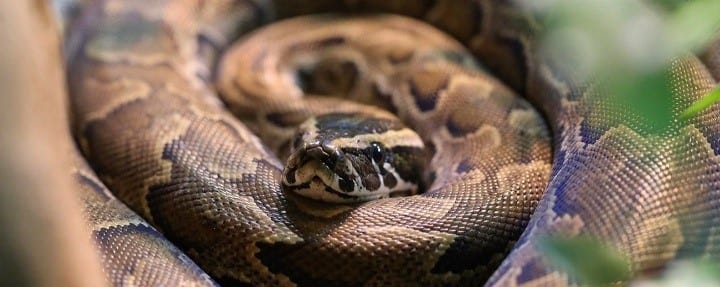
Contrary to other snake species, African rock pythons tend to be quite easy to breed, even for beginners.
Provided one is to keep a male and female Python sebae sebae together, there are high chances for successful breeding. The keepers should not do anything special in order to encourage the breeding process, as in most cases, it happens naturally without external interference.
As a rule of thumb, the most crucial factor for breeding African rock pythons is to ensure that both the male and the female species are in perfect health, as well as that the conditions within the enclosure are maintained precisely based on the basic recommendations regarding desired temperature rates, proper ventilation, hiding spots, freshwater, and high hygiene.
It is important that a gravid African rock python female has access to a nesting box as to be able to lay her eggs. The nesting box must be large enough for the female to turn-around fully when inside the box. In order to keep the nesting box nicely humid and moist, moss can do a brilliant job.
When it comes to incubating the eggs, keepers are recommended to use an incubator set at 84 degrees Fahrenheit.
It is essential that the eggs are to be incubated in well-sealed boxes. Another wonderful option is to use moisture-rich substrate capable of trapping the humidity around the eggs for successful incubation.
After the first baby African rock python babies hatch, they will encourage the rest of the eggs to hatch, too. When keepers are in charge of incubating the eggs, the babies will usually start hatching within about 60 days or so, which is faster than the average period of 90 days for hatching the eggs in the wild.
Handling

The only way to tame these mesmerizing creatures is by regular handling.
Despite their bitter, dark reputation of aggressive animals fully capable of killing their owner, when captive-bred African rock pythons are raised with genuine care and love, they can make wonderful, calm, semi-docile companions.
However, this will not happen automatically as time goes by but depends solely and strictly on the keeper’s attitude towards the reptile. When it comes to handling an African rock python, proper training that starts from an early age is crucial.
Caregivers should start handling the African rock python gradually, allowing for the snake to get used to the process, without forcing it.
Do NOT attempt to handle an African rock python when feeding it.
DO NOT attempt to handle the snake after you have touched any kind of food that can stimulate the serpent’s appetite, literally teasing it to attack you.
If not fed properly, handling should be avoided because of higher chances for the snake to attack searching for food.
The snake should feel comfortable before being handled since if the reptile is to sense any form of threat, it will inevitably deliver a series of painful bites.
Socialization is extremely important with these snake species, especially as far as handling is concerned.
Provided there are no free-roaming pets, small children or elder, vulnerable people, an African rock python can be allowed to have free range in the house, too.
How to Treat and Prevent Possible Health Issues
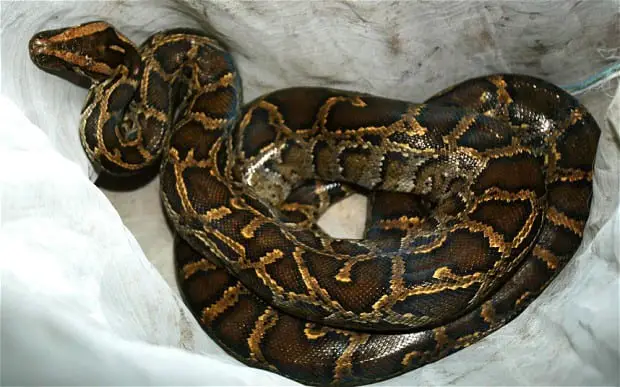
Parasites and Infectious Diseases
Wild-caught African rock pythons are prone to a wide range of serious health problems, including but not limited to both internal and external parasites.
It is important to note that external parasites, such as mites and ticks, can affect even captive-bred African rocks. Because of this, keepers should keep an eye out for tiny red, black or white moving spots and immediately contact a herp vet so that the eventual treatment can be as mild and quick as possible.
Inclusion Body Disease
Inclusion Body Disease (IBD) is a severe snake disease that is carried by both boas and pythons.
Similarly to AIDS in humans, IBD is a retrovirus. In some cases, the affected snake species can die within as little as a few days of exposure. However, the disease can linger for months or even years.
Typically, exposure to IBD occurs when an infected snake is to share an enclosure with non-infected snakes. In most cases, this happens either during breeding or cohabitation.
It is a MUST to house your African rock pythons separately at all times, except for when it comes to breeding. When breeding a male and female African python, always consult a qualified veterinarian in advance as to be sure of the health status of both of the serpents.
Also, do never place an African rock python in the same enclosure with a boa.
Respiratory Infections
Respiratory issues, such as reptile pneumonia, may occur when taking care of an African rock python. Fortunately, provided the cold is caught and treated in a timely manner, it is easily fixable.
You can notice if your African rock python is to suffer from a respiratory disease if the reptile is to hold its head upright in an attempt to breathe. Sometimes, it will also wheeze.
In the case of dealing with respiratory issues, the first thing keepers should do is to ensure that there is a properly maintained gradient within the enclosure. Of course, a vet should be also contacted immediately.
If the respiratory disease is to occur and to remain unnoticed for a particular period of time, during the more advanced stages the African rock may ooze a foamy, cheesy-like substance from its vents or mouth.
Possible Dangers to Humans
Although not venomous, the bites of African rocks are especially painful because of these snakes’ numerous, recurved teeth. The bitten spot can quickly become infected if not treated properly and promptly.
Not the least, the constricting power of African rock pythons is not to be underestimated. Duo to their large size, these snake species can constrict their victim with voraciously ferocious, strong grip.
Even when kept in captivity for a long time, a wild-caught African rock python will rarely get to acclimate to being confined within a cage, as well as for being handled.
African rock pythons are not the best choice for captive husbandry.
Availability: How to Get an African Rock Python?
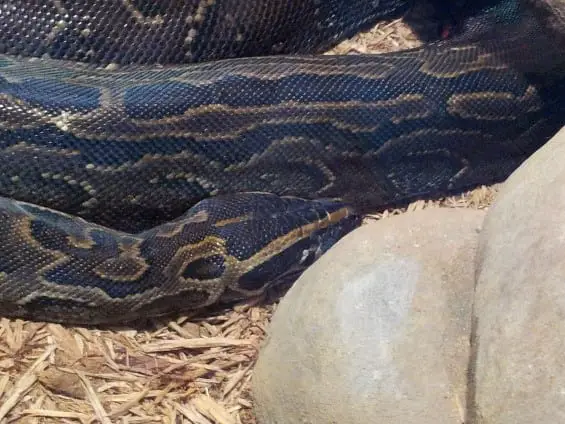
African rock python enthusiasts must always buy their pet snake only from reputable breeders or retailers.
Do never get an African rock python from the wild, attempting to domesticate it, as this is practically impossible. Also, a wild-caught specimen is certainly to carry various disease.
The best way to get a healthy Afrock that you will be able to tame (at least to some extent), is to pay attention to the selection process and never purchase these amazing creatures from the black market.
Fun Facts
1. One of the most famous African rock python specimens was the one that got killed in 1959 by K.H. Kroft. The specimen was reported to have reached a length of 23ft (7 meters). A juvenile Nice crocodile of 4ft (1.5 meters) in length was said to have been found within the dead snake’s stomach.
2. Probably one of the largest African rock python specimens ever recorded was killed in the Gambia. The reptile measured the impressive 24ft 7 inches (7. 5 meters) in length.
3. The size of African rock pythons varies quite considerably, depending on the different areas these serpents may inhabit. For instance, in more populated regions, such as Nigeria, African rock pythons are known to be smaller than those capable of reaching full length in less populated areas, like Sierra Leone.
4. African rock pythons have visible, although small pelvic spurs. These pelvic spurs are believed to be the vestiges of hind limbs, the two back limbs of the ancient Afrocks.
5. It was in 2009 when an African rock python was surprisingly found in the Florida Everglades. This news has brought a lot of fear ever since, as the local population is worried about Afrocks possibly establishing themselves as invasive species in the region, similarly to the already well-established Burmese python population in the area.
How to Take Care of an African Rock Python
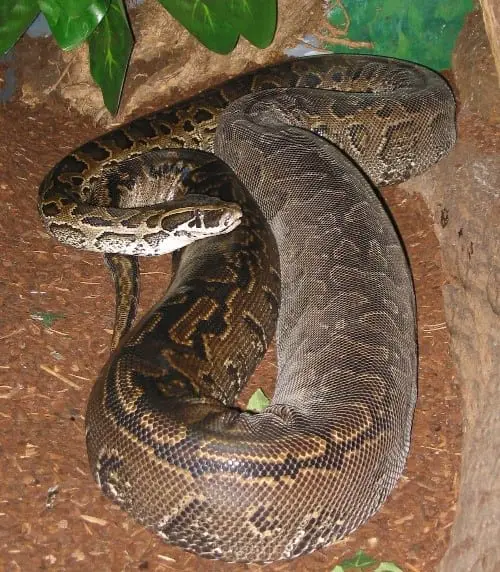
- African Rock Pythons grow very large. With this in mind, they have pretty much the same housing requirements as other giant snake species, such as boas, among others. Do never confine an African rock python inside a smaller enclosure than recommended, as this will inevitably make the reptile more aggressive and hostile to interaction with its owner.
- African rock pythons have a significantly longer lifespan than many other types of snakes. Also, they do require a permanent food source that only gets bigger as the Afrock gets bigger. Because of this, African rock pythons require specific care with a mind to the long run, so they are definitely not the right pets for every reptile lover out there.
- African Rock Pythons share certain similarities with reticulated pythons as both species can have quite naughty temperaments. Captive-hatched and raised Afrocks can be tamed with patience, persistence, and consistency, however, they make a good choice only for the advanced herpetoculturists and not for the novice.
- Ill-raised and/or poorly socialized African rock pythons can be very dangerous and very aggressive. They will not doubt to attack a human being, an eve their owner, if they are not fed and/or attended to properly, or if they feel threatened. It is the caregivers’ responsibility to socialize these whimsical creatures, but this requires diligence and time, so if you do not feel that you can provide what is needed to tame an Afrock, it is best to choose another reptile pet as not to harm yourself or the python.
- With regular (never forceful) handling, African rock pythons can become well-socialized. Then they can be allowed to roam the house freely on a daily, weekly, and/or monthly basis, provided the caregiver ensures the right conditions so that the reptile will not accidentally get to harm itself or another living creature. They can make very quiet and clean companions.
FAQs
Can African Rock Pythons Eat Humans?
The short answer is yes, African rock pythons are capable of eating a human, but this greatly depends on the weight and height of the person. However, despite their notorious reputation, there have been very few recorded cases of Python sebae sebae attacking people. Because of their flexible skin and jaws, these snake species are able to eat almost any warm-blooded animal, especially as their lower jaws are attached to their skills only very loosely.
Are African Rock Pythons Aggressive?
Captive-bred African Rock Pythons that have been properly taken care of are not aggressive animals, despite their bad reputation on that note. In the wild, though, Afrocks can get quite aggressive, and they are also very defensive animals that are not afraid to attack when threatened.
Are African Rock Pythons Dangerous?
Just like every other animal, an African rock python may or may not be dangerous, depending on a number of factors. Most importantly, this snake species is non-venomous, and if approached with respect and understanding, it usually poses no threat to humans, although Afrocks inhabiting suburban areas are known to feast on the local population’s poultry and goats. African rock pythons can be especially dangerous if children are left unattended with these serpents.
Do African Rock Pythons Make Good Pets?
Captive-bred African Rock Pythons can make wonderful pets for the right owner, provided the animal is treated properly, with the needed caging, care, and respect. Although there have been a few recorded incidents with captive African rock pythons, the news does much more to sensationalize these incidents rather than to clarify and reveal the truth about African rock pythons kept as pets. The temper of an Afrock python will reflect the owner’s level of care and diligence.
Are African Rock Pythons Suitable for Beginners?
No, African Rock Pythons are definitely not a suitable choice for beginner caregivers. A keeper should only consider taking care of an Afrock provided that he/she has already accumulated some solid experience with easier-to-look-after snakes, such as Green tree pythons.
Do African Rock Pythons Smell Bad?
Provided the owner is to clean the African Rock Python’s enclosure diligently and regularly, these snakes do not emit any of a smell. Also, a suitable substrate must be utilized in order to limit any unwanted odors related to taking care of a captive African Rock Python.
Can I Release my African Rock Python Pet Back in the Wild?
Even if an owner is to feel that he/she can no longer take proper care of an Afrock, it is crucial that one is to never release an African Rock Python pet back in the wild. Doing so may have a dangerous, negative impact on native wildlife, and it can also pose dangers to the local population, too. Contact a qualified herp vet in order to receive professional guidelines on what to do with an African Rock Python pet in the case you do no longer want or can take proper care of the reptile.

